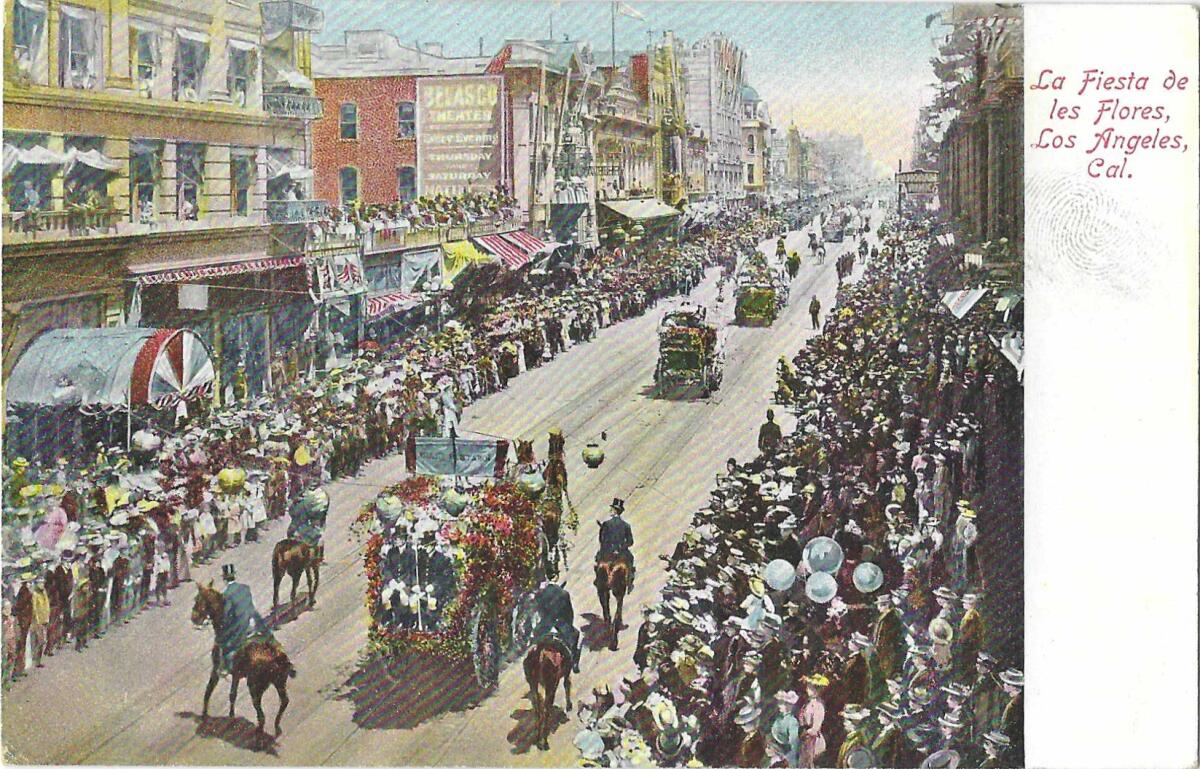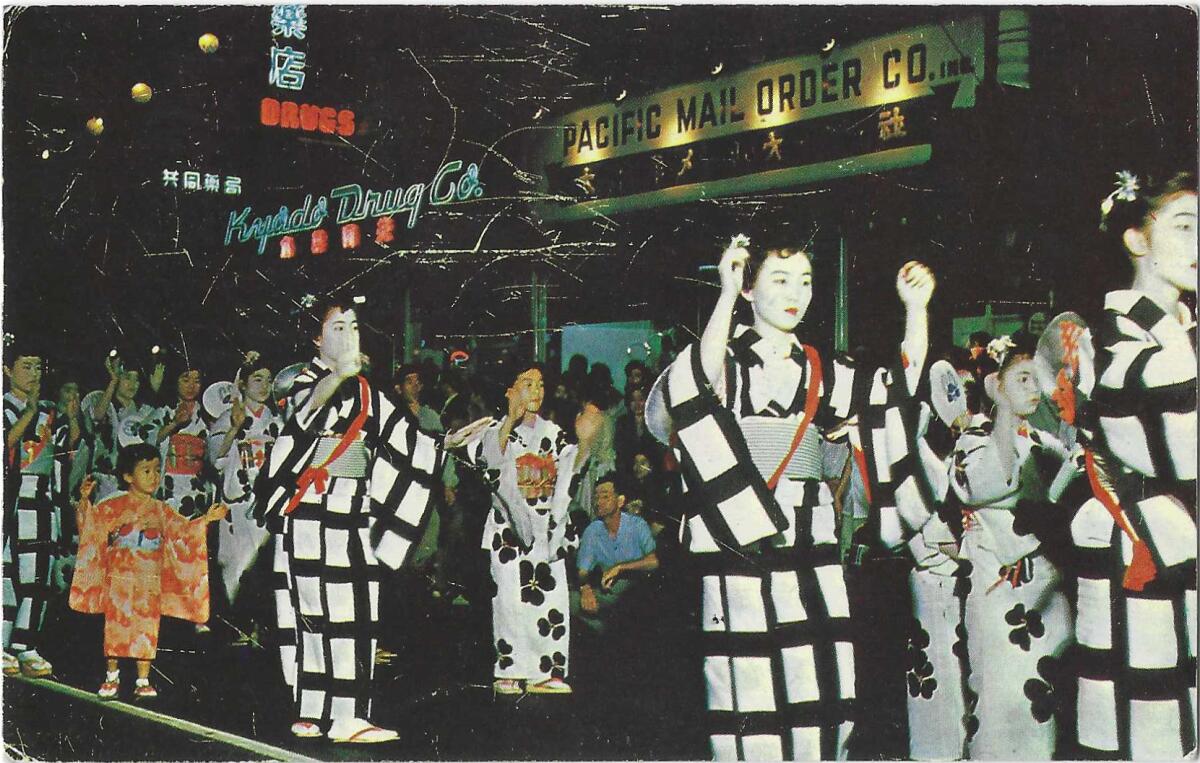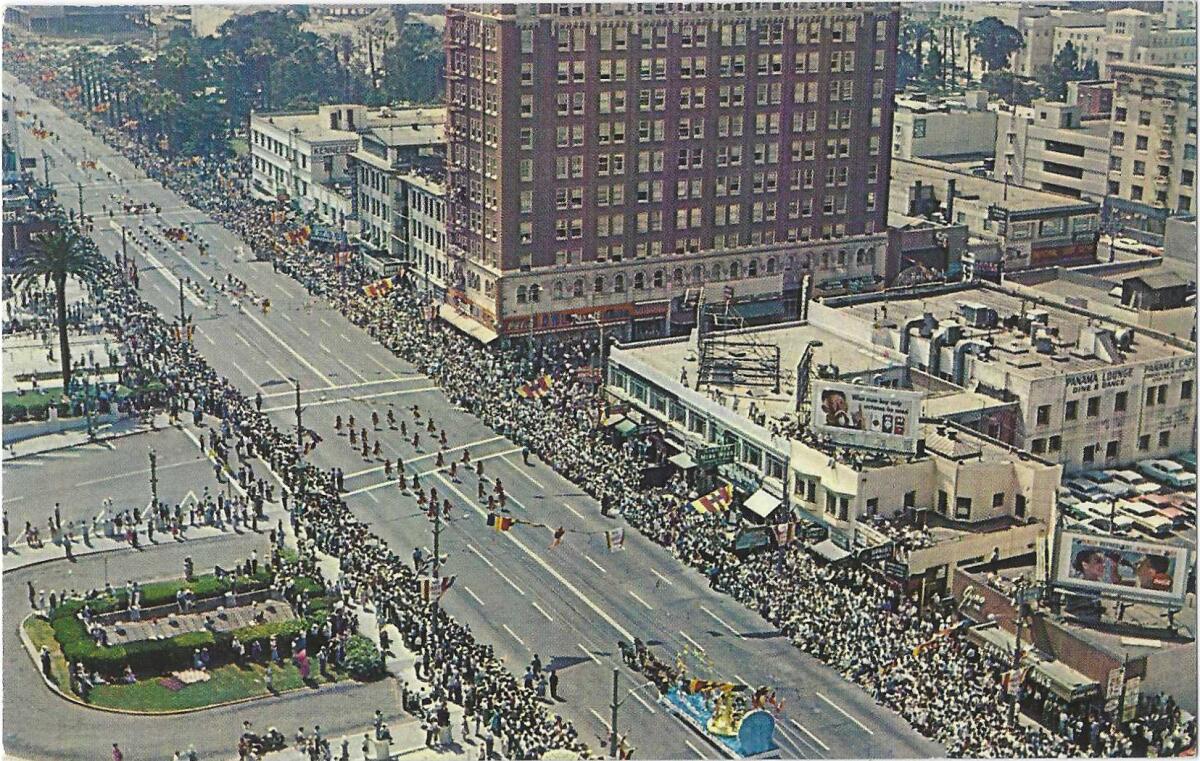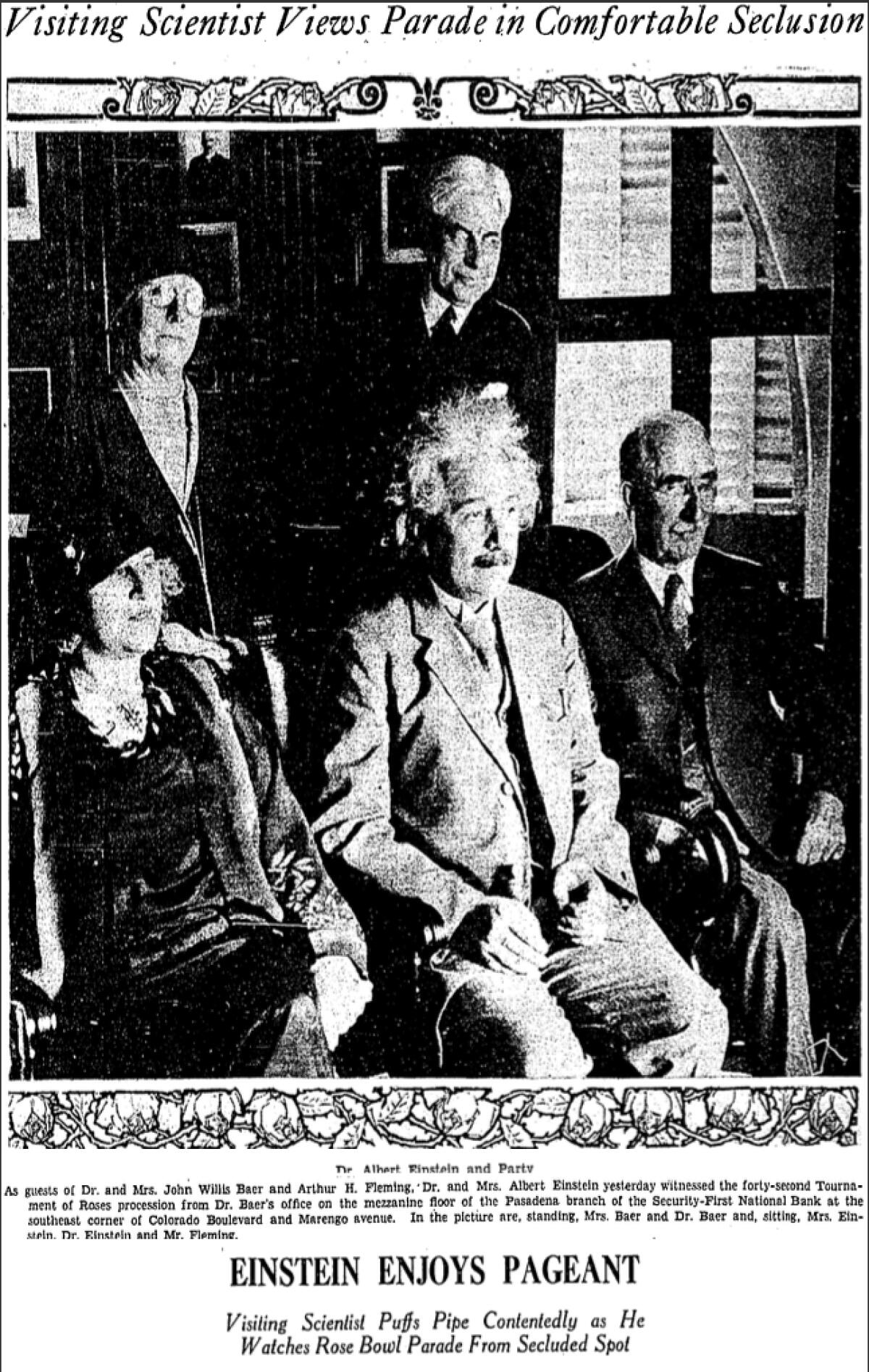That time L.A. got jealous of Pasadena and started its own flowery parade

- Share via
In these parts, “the parade” usually means the parade, the New Year’s Pasadena blockbuster that’s broadcast the wide world over. Body clock permitting, you can watch it live in the Caribbean, in parts of Latin America and in Armenia.
For the perpetually reinventing place that is Southern California, the Rose Parade, dating from January 1890, ranks as practically Mesozoic — older than the zipper, the Teddy bear and the game of basketball.
Unfazed by such hoary competition, cities and neighborhoods across Los Angeles have nonetheless staged their own parades by the score — famous and obscure ones, whimsical and mournful ones, thriving and defunct ones. In sum, we love a parade.
Los Angeles’ city fathers, so adept at ballyhoo, just hated it that the highfalutin’ town up the Arroyo Seco had thought up their big flowery promotional parade first. So in February 1894, L.A. conjured up the Fiesta de las Flores, a title chosen in a competition above submissions like “Angels’ Carnival,” which to modern ears is more suggestive of an Anne Rice novel than a floral street party.
Cities and towns all over the county fielded entries; those that did not — well, there was almost a tone of menace to the chairman’s remark that “communities not represented on this occasion will receive criticism, without a doubt.” Floats, carriages, pageants, musicians were all in the running for cash awards and prizes such as sets of underwear and Hungarian vases.
This fiesta’s date was not in January but in April, a month when even winter-bound latitudes can show off blooming flowers. In fits and starts, this fiesta went on until 1916. A visit by President William McKinley moved it to line up with his May arrival, and his parade automobile, covered in 10,000 carnations, was the fiesta’s high-water mark. The fiesta was revived briefly in the 1930s to coincide with the September anniversary of the founding of L.A., and thereafter — well, game, set, and match to Pasadena.
Get the latest from Patt Morrison
Los Angeles is a complex place. Luckily, there's someone who can provide context, history and culture.
You may occasionally receive promotional content from the Los Angeles Times.
Special interest parades — originally of, by and for a particular community — have always had loyal and localized fans, but over time, their reach has widened.
Chinatown’s Lunar New Year events now get ecumenical crowds, and even in the late 19th century, the parades for Chinese mid-autumn festivals brought out non-Chinese spectators, though The Times’ coverage of them, describing for white readers the “pagan pageant” and “blowout of the Mongolians,” was a reminder that the vicious Chinese massacre of 1871 had happened less than a generation before.
L.A.’s civic powers turned around and besought the Chinese leaders to take part in the official fiesta, assuring them that doing so would bring about “a greater understanding of their race and greater harmony with the American people.” Covering the meeting, The Times described the Chinese with the pejorative “Celestials,” as figures of “sphinxlike” demeanor.


Little Tokyo’s Nisei Week parade and events thrived both before and after the forced disruptions and relocations of World War II. In the 1920s and ‘30s, Little Tokyo was the biggest Japanese American community in the continental U.S., and the festival boosted its business and culture during the Depression. Barely three months before the Pearl Harbor attack, The Times wrote about the festival. And then — for seven years, during and after World War II, nothing, and then nothing again for two COVID-stricken years. That’s why the banner leading the parade this August read “80th Annual Nisei Week Japanese Festival.” Its reach and crowd appeal now is beyond the Japanese community.
For something like 100 years — and more that probably went unrecorded — celebrations of Mexican independence day (Sept. 16, not Cinco de Mayo) have sent rolling festivals through the streets of Los Angeles’ Eastside communities. (See a pictorial here, published in The Times in 1942, for one example.)
One barometer of changing L.A. is how often politicians who are not Latino or Asian American or Black have been angling to appear in a parade to be seen as “down” with a particular culture — and its voters.
At the 1993 Martin Luther King Jr. parade, some of the two dozen candidates to succeed Mayor Tom Bradley after his 20-year reign as L.A.’s first Black mayor showed up to ride along. Miss Black Los Angeles marveled, “They all want to be photographed with me” — not something that would have happened 20 years before. What did happen 20 years before, at Bradley’s inaugural parade, was a turnout of American Nazis in tan shirts and riot helmets, carrying racist signs.
South L.A. put together an impromptu parade of mourning in June 1963, after civil rights activist Medgar Evers was assassinated in his own driveway in Mississippi. Fifteen hundred Angelenos, a quarter of them white, marched along, singing hymns and patriotic songs. At an assembly point, about 250 cars with “funeral” signs in their windshields waited to drive mourners to church for a memorial service.
Towns and communities often save their parade firepower for the holidays — sometimes July 4, but more often Christmas. San Pedro, Compton, Granada Hills and Highland Park are hitting the streets with December parades, and Marina del Rey’s boats will hit the waves with the same theme. The Hollywood Christmas parade gets the most buzz; it’s advertising this year’s as the 90th annual, but a 1933 Times story says that year’s parade would be the tenth annual. Where did those other years go? War and COVID cancellations, probably.
That parade began to help merchants rev up holiday shopping, and in the Depression, parades were a make-or-break moment for businesses hanging on by their fingernails. But Easter parades downtown and along Wilshire Boulevard never did acquire the cachet of New York’s, nor the drawing power of the Hollywood Bowl Easter service.
It’s yet to be determined if Karen Bass will break the long string of men who have held L.A.’s highest elected office. Here are the stories of other women who have run for mayor or briefly served.
As for Labor Day in a traditionally anti-labor city like L.A., the numbers are almost impossible to believe, they’re so big. But if anything, the union-hostile Times would have shaved off a few thousand.
But here’s the 1941 parade by the numbers: five hours and 50 minutes long, 150,000 parade marchers led by 15 Teamsters on motorcycles. The letter carriers alone took an hour to pass the reviewing stands; the CIO members — that’s the Congress of Industrial Organizations — took two hours; the office workers’ branch was especially popular — its women members wore shorts. Massive floats showed shipbuilders and aircraft carriers at work. The newspaper workers’ float — none of them worked at The Times — showed the interior of a newsroom and a photographer “snapping a picture of a divorcee.”
Unions from Florida, Colorado, New Mexico and Massachusetts sent entrants. Among the judges: Oscar-winning actress Gale Sondergaard and Oscar-winning screenwriter Dalton Trumbo. Ten years later, during Congress’ “red scare” hearings, Trumbo and Sondergaard’s writer-director husband had spent time in prison as two among the blacklisted “Hollywood Ten,” and Sondergaard’s career was tanked by her politics.
For a time, Southern California had more military parades than Christmas parades. Memorial Day, July 4 and Armistice Day, now Veterans Day, sent thousands of veterans into the streets. In 1895, 30 years after the end of the Civil War, aging Union soldiers strutted their old colors through downtown.
During and after World War II, memorial parades for World War I veterans and its dead were joined by recent service members. Over several years in the 1940s, the city saw not one but two November parades on the same day: one by the Veterans of Foreign Wars, and the other by members of the American Legion. For several years too, August parades celebrated VJ Day — victory in Japan, the end of the war in 1945. In 1948, one of them included a review of 400 Nisei veterans of the nation’s battles in Italy.
Angelenos can be pretty blasé about big public events; mostly, they mean bad traffic. But they will turn out for sports parades if there’s something worth celebrating: the Lakers’ NBA championship victories, the Dodgers’ too-rare World Series wins, and the Rams’ Super Bowl fete last February.

From 1952 until 1960, long before Donald Trump bought it, the Miss Universe pageant was hosted by Long Beach, which sent the contestants out into the streets of the city before they competed for the crown and sash in the stupendous TV ratings-getter.
Another kind of parade made the news in Long Beach in 1960. What the NAACP expected to be a very small protest, the third in three weeks, against segregation outside two dime stores’ lunch counters turned out to be too big: about 250 people showed up, and the organizers called off the parade out of fears over traffic congestion — which would have given police an excuse to shut the whole thing down.
I do have a favorite. I admit it: Pasadena’s Doo Dah parade.
In 1978, Jan. 1 fell on a Sunday, as it will this year, and the Tournament of Roses is a never-on-Sunday operation. But Pasadena’s streets were not empty. Instead, there appeared a cheeky, on-the-fly production of anarchic whimsy — I described it as “Monty Python” meets a Yippie convention.
Over the years the Doo Dah sent out crowd-pleasers like the Synchronized Briefcase Drill Team, junior execs from United California Bank (“Preeeeesent ATTACHES!”); a drum and beagle corps with real beagles and beagle-free dogs; the Unknown Shoppers, with brown bags on their heads, pushing grocery carts haphazardly along Colorado Boulevard; Planned Parenthood human-sized costumed figures of Dolores Diaphragm and Herm the Sperm.
It was madcap and haphazard and the perfect antidote to the perfection of the other Pasadena parade.
One spectator, from Sierra Madre, said sagely, “I’m surprised Pasadena allowed it, and it’s great they did. I figured anything this fun they wouldn’t let happen.”
Well, the Doo Dah was kind of lightning in a jar. It went along just fine for some years — peaking at about 100 entries and 60,000 spectators — but it was hard to reproduce the quicksilver nature of the earliest parades.
As it got more popular, it got more organized. The TV broadcast rights people wanted more predictable schedules and more disciplined orders of march. To the dismay of parade purists, programs were printed up — programs! The city nudged the event around on the schedule, and after a COVID suspension, this year’s Doo Dah was a placeholder party last Sunday that promised great things for next year.
You know who would have loved the earlier, funnier Doo Dah parade? The Rose Parade’s most famous spectator: Albert Einstein.
He watched the 1931 parade from a mezzanine window of a bank building on the corner of Marengo and Colorado, and the only time he really laughed at what was going on in the street below was when things went awry, a little wire-haired terrier broke out of the crowd and tried to play with a troupe of horses bearing American Legionnaires. Only then, wrote The Times, did the “quiet German scientist” let loose with a “shoulder-shaking chuckle.”

Explaining L.A. With Patt Morrison
Los Angeles is a complex place. In this weekly feature, Patt Morrison is explaining how it works, its history and its culture.
More to Read
Get the latest from Patt Morrison
Los Angeles is a complex place. Luckily, there's someone who can provide context, history and culture.
You may occasionally receive promotional content from the Los Angeles Times.















